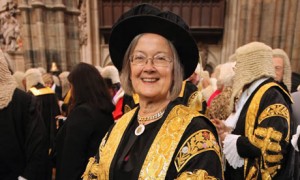Share it
 On 20 October 2010 Lady Hale closed ‘Happiness Pursued: A Celebration of Ten Years of the Human Rights Act’, organized by the Human Rights Lawyers Association and The University of Notre Dame, with reflections upon the Supreme Court’s first year. Comparisons between the Supreme Courts of the United Kingdom and United States had been a theme throughout the day, and whether the two courts had anything increasingly in common other than a name.
On 20 October 2010 Lady Hale closed ‘Happiness Pursued: A Celebration of Ten Years of the Human Rights Act’, organized by the Human Rights Lawyers Association and The University of Notre Dame, with reflections upon the Supreme Court’s first year. Comparisons between the Supreme Courts of the United Kingdom and United States had been a theme throughout the day, and whether the two courts had anything increasingly in common other than a name.
In evaluating the Court’s first twelve months, Lady Hale emphasised the continuity between the work done by the Law Lords and that carried out by the Supreme Court; ‘As I see it, we do the same job, in more attractive surroundings and more open to the world’. Lady Hale pointed out that the legal criteria enabling a case to come before the Court had not changed and neither had the nature of the Court’s power and jurisdiction. Lady Hale was keen to emphasise that decisions of the Court that have been hailed as bold and progressive, for example the decision in HJ (Iran) v Secretary of State for the Home Department, would have been decided similarly in the House of Lords.
Lady Hale quashed assertions that either the Court’s new location or the frequent occasions upon which the Court sits as a panel of nine reflect the Court’s desire to assert itself more readily. The new location, facing the seats of temporal and spiritual power in the shape of Parliament and Westminster Abbey, is a more accurate reflection of the Court’s true position and independence within the British constitutional system. The panels of nine rather than five prevent the embarrassment of a 3-2 split decision.
A number of interesting points were raised during the Q&A session. As the only woman in the Court, Lady Hale was asked if she ‘ever got lonely’. Responding with amusement she said that she did not, as her colleagues were all ‘very nice’, but at times the gender differences might contribute to differing points of view on case. This was perhaps evident in the decision delivered that very same morning in Radmacher v Granatino, an 8-1 decision with Lady Hale in the minority.
Lady Hale also drew attention to the financial position of the Supreme Court, which unlike its predecessor, no longer has a ‘direct line to the money’. This financial change was of little concern when the Court was established as no one ‘visualised the mess we are in now’. However, with courts up and down the country feeling the squeeze and the propensity of the new government to refer to the Supreme Court as a quango, this change in funding arrangements may well give cause for concern.
Given the emphasis on continuity and the lack of change with regard to both the new Court’s decisions and jurisdiction, it may be asked if Lord Neuberger was right – has an awful lot of money been spent in order to achieve no change at all? Lady Hale’s answer was a firm no; the removal of the United Kingdom’s highest court from the House of Lords was long overdue. Furthermore, the new Court’s accessibility and high profile was a theme Lady Hale continually returned to. Certainly, the figures for the Court’s first year are impressive. 19,000 people visit the website a month. Almost all proceedings are filmed. 55,000 people visited the Court last year. As Lady Hale noted wryly, this is considerably less than the Tower of London, but all things considered it is pretty good for an attraction that has neither a spectacularly gory history nor a flock of in house ravens.
Anita Davies is a BPTC student at City Law School and an Inner Temple scholar.



1 comment
Anonymous said:
27/10/2010 at 09:00
Whilst well meaning, Lady Hale’s comments grate somewhat given the current context of court closures and other cost cutting measures in the law and order world. Slightly ironic that these comments come at a human rights event celebrating the progress brought by the Human Rights Act 1998; unfortunately, access to justice (i.e. right to a fair trial – for all I might add), supposedly one of if not the most important principles of our legal system, costs money. Slightly unconfortable it is then that we prioritise pleasant surroundings for the illustrious 9 rather than legal aid and lower level courts for Joe and Jane Bloggs.
Although an empty threat, it is then perhaps no surprise that the Supreme Court is on the list to become kindle on the quango bonfire. £150 million well spent? Apparently, not even Lady Hale thinks it is worth the money.